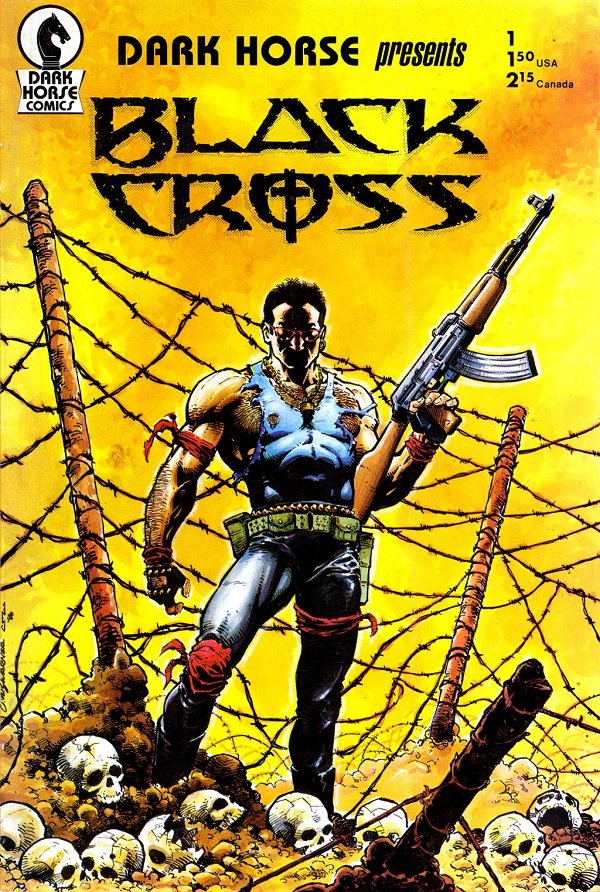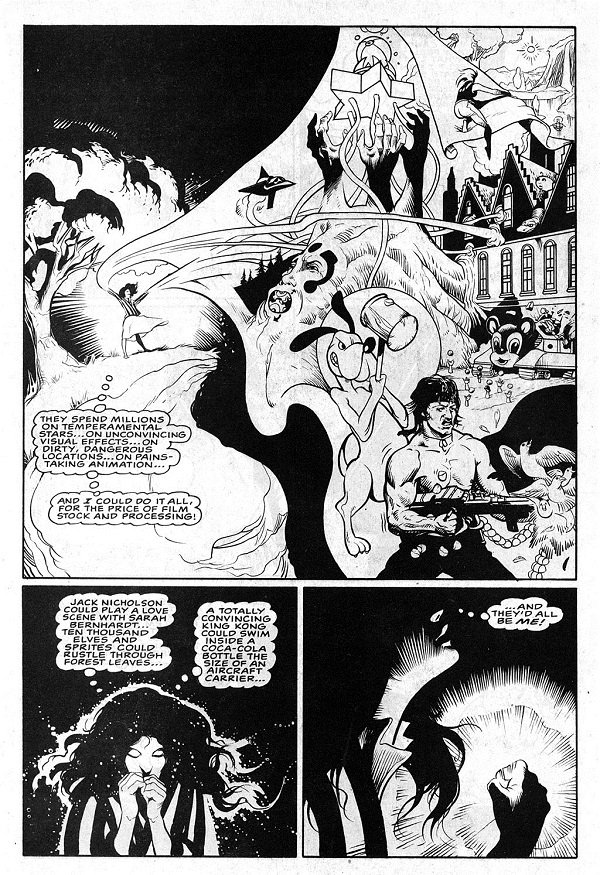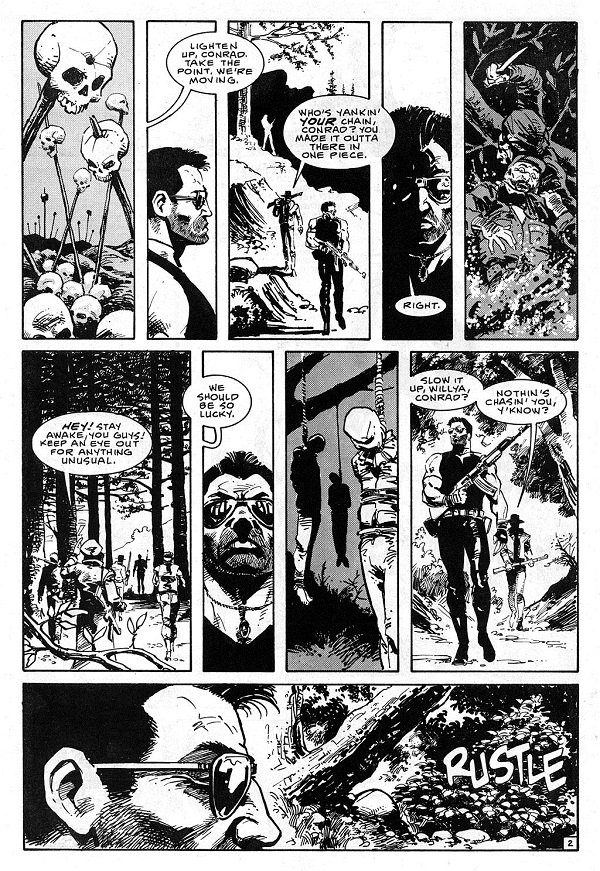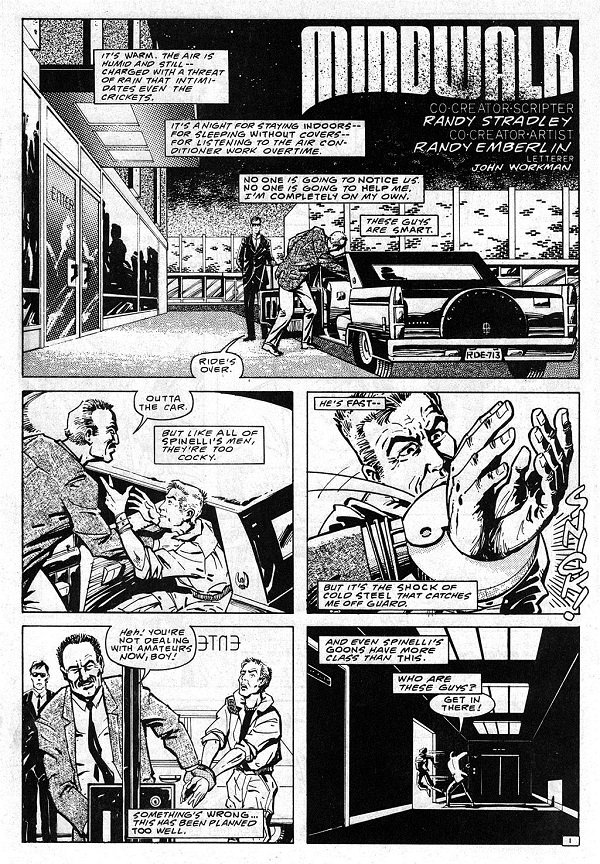Michael's Long Box - Dark Horse Presents #1 (July 1986)

While every month is an important month for comic buffs, July holds a special place in my heart. For it was in July that Mike Richardson introduced the world to a new small press studio, a sandbox for the type of stories and artwork that didn't fit the needs of Marvel and DC, a publisher who neither bowed to the Comics Code Authority nor believed that comics were solely for young readers, a place where creators would retain ownership of their own materials instead of signing over the rights to the heroes, villains, and worlds they birthed on the page. He branded his company 'Dark Horse Comics', hired Randy Stradley as a partner and editor, and what you're looking at is the very first issue of the very first book they sent out to stores in the summer of 1986. This is Dark Horse Presents #1.

A page from Paul Chadwick's Brighter
DHP was conceived as an anthology series. Instead of printing one book-length story per issue, Richardson and Stradley took inspiration from Japanese manga titles like Weekly Shōnen Jump, Big Comic Spirits, and Shōjo Friend, where each issue contained single chapters of multiple long-running stories from various creators. Thus, instead of having a single creator or team responsible for churning out 20+ pages every issue, the work could be split between multiple individuals, each responsible for their own portion of the book's total page count. For their writer and artist talent, Richardson and Stradley reached out to their friends from APA-Five, an amateur press alliance of like-minded folks who wrote, drew, and published their own 'zines. They nabbed folks like Paul Chadwick (who had just finished penciling Dazzler for Marvel) and Randy Emberlin (inker of American Flagg for First Comics) from this group, poached Chris Warner off his current job drawing Doctor Strange, and the stage was set.

A page of Chris Warner's Black Cross
Richardson knew Dark Horse Presents would be a hard sell as an unknown property featuring largely-unknown creators produced by an unknown company. Dark Horse's small press status meant they couldn't secure the kind of discounts on paper enjoyed by Marvel and DC, so their cost-per-issue would be higher. To help offset this, Richardson and Stradley made the same decision many other independent presses made, and printed Dark Horse Presents as a monochromatic book. No color meant no need to hire colorists, and no need to subject the work to the four-color process, but it also was the equivalent of shooting a black-and-white television show at a time when every home in the US had a color set. Richardson was gambling the older, more mature audience he sought wouldn't be put off by a lack of color.
But even trimming out the color, producing a company's first comic is an expensive endeavor. Stradley and Richardson had contracted with their creators to return 100% of the book's profits to them, but this presented a conundrum: in order to share profits, the book had to sell enough to cover the cost of its production, and despite trimming every ounce of fat possible from the budget of printing and shipping their book, Dark Horse Presents #1 featured a cover price of $1.50 US, and $2.15 in Canada. In an era where it's not uncommon to pay $3.99 or more for a single book today, that might not seem like a big deal, but in 1986 the average cover price for a comic from DC and Marvel was only seventy-five cents. Dark Horse either had to convince buyers on a budget to forego two issues of whatever other mainstream titles they were reading, or gamble that extra buck-fifty on an unknown commodity from an unknown company with an unknown track record using unknown talent.

A page from Paul Chadwick's Concrete
What's more, Dark Horse had invested heavily in itself and its artists: between creator compensation, advertising in industry publications, and printing costs, Richardson needed to recoup $15,000 in order to just break. Dark Horse Presents #1 would have to sell 10,000 copies to make that happen. At a time when most small presses would kill to hit 10% of that goal, this is a nigh-insurmountable hurdle. And yet, something extraordinary happens.
Dark Horse, whether through advertising which appeals to adults who thought they outgrew comics, word-of-mouth by shop owners and readers, the power of Chris Warner's cover artwork, or a combination of all of the above, sells through its entire first printing of Dark Horse Presents #1, orders a second, and sells through that as well. In later years, DHP #1 is reprinted twice as a special "Commemorative Edition"; these are scooped up by new fans eager to avoid the $7-10 price tag the original printings command on the second-hand market by the mid-90's. All told, Dark Horse Presents #1 sells over 50,000 copies of their first issue, enabling not only an enormous return to the creators on their investment of time and talent, but also proving to Richardson and Stradley they're on to something with their idea. After all, with numbers like that, they now have writings and artists beating down their doors and can afford to take risks publishing stories they want to read, written by people who wanted to write them and artists who wanted to draw them, instead of just the next issue of "Generic Superhero Book". It's all Richardson has ever wanted to do since he had the idea of founding the company, and DHP #1 has made that dream a reality.

A page from Randy Stradley and Randy Emberlin's Mindwalker
With thirty-two black-and-white pages devoid of ads save for a single plug for Dark Horse's other title released that month, Boris the Bear #1, and a plug for Northwest Comic Company out of Aloha, Oregon, Dark Horse Presents catalyzed and showcased the need for creator-owned publishing six years before Image. Its pages became home to a number of first-time creators, as well as a sandbox for established writers and artists like Frank Miller, Matt Wagner, and Chris Claremont to explore stories and ideas that didn't fit the needs of Marvel and DC. If you've ever enjoyed an issue or arc of Concrete, Sin City, Hellboy, Buffy the Vampire Slayer, Predator, Aliens, The Terminator, B.P.R.D., or Umbrella Academy, then you owe a debt of gratitude to a small group of guys who made it all possible thirty-three years ago.
A 'dark horse' is an idiomatic expression in English meaning, "a unknown competitor who comes out of nowhere, yet winds up winning". Given that they're still going strong three decades later, Mike Richardson's choice of name for his company couldn't have been more prophetic. They came from nothing to become the third-largest comics company in the United States. And that, my friends, is a story worth celebrating!
Sup Dork?!? Enjoy the Upvote!!!
I want to say that i used to collect Dark Horse comics when I was a teenager but I am not certain about this. It has been many many years since I bought or have even seen a comic book because they are not very popular as collectibles here in Thailand.
Nice thorough writeup!
Thanks, @gooddream! Depending on when your teenage years occurred (though I suspect we have some overlap in that regard), it would have been hard not to notice Dark Horse material in the comic shops. What kind of titles did you enjoy back then? I'm fairly familiar with the Dark Horse catalog from 86-96 or thereabouts. :)